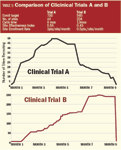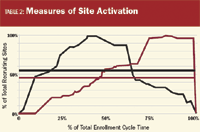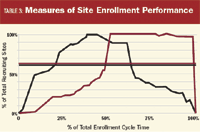Finding the Sweet Spot
How proper site activation and site enrollment can help you get the most from clinical trials.
New drug development is risky because it involves testing potentially lethal compounds on vulnerable and frequently sick patients. The dangers are enhanced by the growing insistence of regulators that potential medicines be tested on ever larger populations based on hard-to-quantify characteristics of health status, age and gender, and in diverse geographic settings that are often unfamiliar to the sponsors. As part of our continuing coverage of best practices in the conduct of clinical trials, Pharm Exec asked a leading trial management expert to examine how quantitative measurement and analytics can enhance the predictability of what is arguably the most daunting challenge facing sponsoring companies—patient recruitment.

(JOHN FOXX/GETTY IMAGES)
Numerous surveys show that finding the right patients to participate in a clinical trial can spell the difference between success and failure in getting a promising compound blessed by regulators and launched to the market. Poor recruitment strategies pump up costs, divert scarce resources, consume more time and ultimately delay these very patients – and tens of thousands of others – prompt access to the medicines they need. An accessible and feasible quantitative approach to patient enrollment that helps sponsors identify specific opportunities and improve their procedures is long overdue.
Traditionally, patient enrollment has been measured by the number of patients enrolled per site per month, which is called the "enrollment rate." This measure implies that patient enrollment is a site performance issue. However, site enrollment performance is not the only factor that drives enrollment cycle times. Experience buttressed by data indicate that the sponsor's business processes, as measured by indication-specific site activation timetables, is actually the determining factor in accelerating enrollment cycle times. Therefore, the traditional way of viewing patient enrollment – being determined by site performance alone – is incomplete. Site activation, an important part of clinical trial start-up activities, actually plays the key role influencing overall enrollment cycle time.
MEASURING SITE ACTIVATION
There are different ways to measure effectiveness in trial site activation. The cycle time of site activation is one. Site activation starts from the time the first site is activated or initiated, and ends when the last site is activated. The less time between the first site activation and the last site activation, the more effective the overall activation process will be. As in the process of enrollment, site activation cycles depend on many variables, making it difficult to compare one clinical trial against another.
Recently, PhESi developed the concept of the Site Effectiveness Index (SEI), which defines how effectively selected sites in a clinical trial are utilized. There are two ways to measure SEI. One is the percentage of selected sites open for enrollment over the duration of the enrollment cycle time. Another is from a single participating site perspective; its percentage of time open for enrollment compared to the overall clinical trial enrollment duration. As a percentage, SEI is always represented as a number larger than zero and smaller than one. A real-world case study will help explain the concept of SEI.
Clinical Trial A and Clinical Trial B are two Phase III metabolic disease clinical trials in the same indication with the same design, sponsored by two different companies. By drawing two charts, we see the site activation curves for the two clinical trials along the time line. (See Table 1.)

Table 1: Comparison of Clicinical Trials A and B
Clinical Trial A activated 44 sites while Clinical Trial B initiated a total of 204 sites. It took less than four months for Clinical Trial A to reach the peak of site activation (i.e., for all 44 sites to be actively recruiting), while it took about 10 months for Clinical Trial B to get its selected sites up and running.
Because Clinical Trial A and Clinical Trial B are similar in many ways, any deeper insight requires a methodology to compare the two trials. To achieve that, we define the X axis as the percentage of enrollment duration and the Y axis as the percentage of maximum number of sites activated, instead of the actual number of sites activated. (See Table 2.) By doing that, we see that area underneath the black colored line (Clinical Trial A) covers more than half of the chart area, and the area underneath the red colored line (Clinical Trial B) covers less than half of the chart area.

Table 2: Measures of Site Activation
The two straight lines tell us that more than half of the Clinical Trial A's 44 sites' enrollment capacities were utilized, compared to less than half of Clinical Trial B's 204 sites' enrollment capacities. Using a specific mathematical formula, we can calculate the Site Effectiveness Index (SEI) is 0.55 for Clinical Trial A, and 0.45 for Clinical Trial B. That means that if we were able to improve site activation in Clinical Trial B to be as good as in Clinical Trial A, we would need only 167 sites to get the same job done, instead of 204 sites. That's a reduction of 18 percent of the sites selected.
MEASURING SITE ENROLLMENT PERFORMANCE
Even with improved site activation, Clinical Trial B uses many more sites (167 vs. 44), and significantly longer enrollment duration (13 months vs. 9 months) than Clinical Trial A. If we look at the above study and this time consider a hypothetically modified Clinical Trial B—call it Clinical Trial BM—reaching a maximum number of sites activated in 7.5 months instead of the original 10 months. That brings the SEI up from 0.45 (Clinical Trial B) to 0.55 (Clinical Trial BM), the same as in Clinical Trial A. As shown in the figure below, the total chart area beneath the straight lines then becomes the same. (See Table 3.)

Table 3: Measures of Site Enrollment Performance
As noted above, improvement in site activation can reduce the total number of sites needed from 204 in Clinical Trial B to 167 in Clinical Trial B[M]. But 167 sites, 13 months, and 565 patients is still quite different from the 44 sites, 9 months, and 700 patients in Clinical Trial A. The 44 sites in Clinical Trial A, on average, performed much better in enrollment than those in Clinical Trial B[M.] When we calibrate the TRUE sites by the SEI of 0.55 for both Clinical Trial A and Clinical Trial B[M], it gives 92 sites (167 sites x 0.55) for Clinical Trial B[M] and 24 sites (44 sites x 0.55) for Clinical Trial A. Therefore, the Average Site Enrollment Rate (ASER) is 3 patients per site per month (700 patients/24 sites/9 months) for Clinical Trial A, whereas ASER is 0.5 patients per site per month (565 patients/92 sites/13 months) for Clinical Trial B.
In other words, Average Sites Enrollment Rate (ASER) is independent of clinical trial enrollment duration. For example, if you have four sites opened for enrollment for one, three, five, and seven months, respectively, and enrolled 160 patients in total, the ASER for the four sites is 2.5 patients/site/month (160 patients/4 sites/(1+3+5+7) months). The enrollment cycle time for this clinical trial could be 7 months or 10 months, or even longer—the ASER for the four sites remains 2.5 patients/site/month. (Generally speaking, it is safe to assume that the site opened for enrollment for seven months is likely the best performer among all the four sites.)
Now we can see the picture more clearly: If we were able to select the same number of high enrolling sites in Clinical Trial B as we did in Clinical Trial A, we would only need 34 sites to enroll 565 patients (34 sites = 204 sites x 0.5 patients per site per month/3 patients per site per month) in 13 months. In other words, the enrollment performance (ASER) of the sites in Clinical Trial B and divide that by the enrollment performance (ASER) of the sites selected in Clinical Trial A, that is the portion of the 204 sites needed, which equals to 34 sites
By now, we can see the financial consequences caused by the differences in site activation effectiveness and site enrollment performance. Assuming the cost to activate a site is $20,000 (a representative yet conservative industry estimate), needing 160 more sites in Clinical Trial B compared to Clinical Trial A means $3.2 million more in site activation costs. Assuming a site management fee is $1,500 per site per month, and the study duration is 8 months, there would be $1.9 million more in site management spending for Clinical Trial B.
By adding the extra site activation fees and extra site management fees together, the cost comes to a hefty sum of $5.1 million:
FROM CONCEPT TO TRIAL PLANNING
Incorporating this type of analysis in the clinical trial planning stage enables project teams to define operational boundaries on performance, set realistic time lines, and understand important trade-offs between the number of sites selected versus the number of monitoring resources needed to activate and manage those sites. This helps teams quantitatively identify improvement opportunities in their site selection and start-up processes. Then, when setting performance targets, we can invite all the stakeholders to go through individual parameters to reach consensus based on a common understanding, and align actions/resources to ensure total organizational support in reaching the performance targets.
For example, determining the targeted number of patients per site is generally about determining how many sites to use. PhESi's approach assesses the issue from the perspective of site activation and enrollment performance. We all know that high priority clinical trials generally obtain more resources and financial support. However, effectively utilizing those allocated resources is an entirely different issue. As we saw in the earlier example, more money and resources (applied to activating more sites over a longer period of time) did not, in fact, shorten the enrollment cycle time—instead it prolonged it.
FINDING THE "SWEET SPOT"
If we were able to get data from several dozen clinical trials in a single indication and enroll the same number of patients in each trial, we could look directly at the relationship between the number of sites used and the performance of those sites using Average Site Enrollment Rate (ASER). In reality, we use number of patients per site (Total Enrollment Target/Number of Sites) as a surrogate to number of sites in trials with same enrollment target.
By doing so, we minimize the impact of clinical trials with different enrollment targets, and still are able to understand the impact of number of sites being used when other factors are equal. We found that when number of patients enrolled per site increases, we increase the performance of all the deployed sites in that clinical trial, as measured by Average Site Enrollment Rate (ASER). In other words, by adding more sites to a clinical trial, the result is a reduction in the average performance of the sites the sponsor has activated. If the same number of patients are allocated across MORE sites then each site enrolls fewer patients and the Average Site Enrollment Rate (ASER) goes down.
Sponsors can rely on this approach to find the "Sweet Spot", with just the right amount of sites to ensure targeted enrollment cycle time to maximize the value of available resources against "speed to market' projections. For example, when working on a respiratory disease clinical trial, we find the ASER for clinical trials with biological intervention to be 0.52, versus 0.83 for the clinical trials with small molecule intervention.
This difference is highly instructive to sponsors as it anticipates and reflects the higher level of difficulties for sites to enroll patients in clinical trials with biological interventions for a particular disease. That 60 percent difference between 0.52 and 0.83 is significant enough to guide the sponsor to commit to a larger number of sites being deployed in a biological trial, so that targeted enrollment cycle times can be achieved.
As these parameters are objective and specific, they are easily accepted by project teams and provides a measure of objective performance to senior management. In return, it effectively improves communication and understanding among stakeholders as to the ramifications of selecting more or fewer sites for example.
This approach also provides a structured framework to proactively detect as well as manage possible derailments in the execution of the trial. Root causes for these derailments can be identified in specific areas, such as site activation and/or site enrollment performance. Before merely adding on more sites, study teams can seriously evaluate whether it makes more sense to enhance the enrollment performance of the existing sites (using a variety of methods and approaches), deploy a site activation "SWAT" team to rapidly activate any new sites or at least understand the time line implications of following their traditional site activation process.
Did you Know?: ASSUMING THE COST TO ACTIVATE A SITE IS $20,000 (A REPRESENTATIVE YET CONSERVATIVE INDUSTRY ESTIMATE), NEEDING 160 MORE SITES IN CLINICAL TRIAL B COMPARED TO CLINICAL TRIAL A MEANS $3.2 MILLION MORE IN SITE ACTIVATION COSTS
Gen Li, PhD, MBA is president and founder of PhESi.HE can be reached at gen.li@phesi.com. Beth Harper contributed to this article.
Addressing Disparities in Psoriasis Trials: Takeda's Strategies for Inclusivity in Clinical Research
April 14th 2025LaShell Robinson, Head of Global Feasibility and Trial Equity at Takeda, speaks about the company's strategies to engage patients in underrepresented populations in its phase III psoriasis trials.
Key Findings of the NIAGARA and HIMALAYA Trials
November 8th 2024In this episode of the Pharmaceutical Executive podcast, Shubh Goel, head of immuno-oncology, gastrointestinal tumors, US oncology business unit, AstraZeneca, discusses the findings of the NIAGARA trial in bladder cancer and the significance of the five-year overall survival data from the HIMALAYA trial, particularly the long-term efficacy of the STRIDE regimen for unresectable liver cancer.

.png&w=3840&q=75)

.png&w=3840&q=75)



.png&w=3840&q=75)



.png&w=3840&q=75)


















